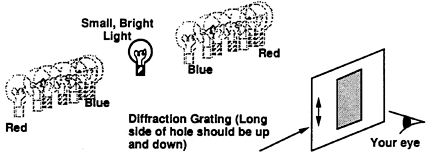Optics Discovery Kit
Experiment #7 :
DIFFRACTION GRATING
EQUIPMENT: Diffraction Grating, Color Filters, and a small bright light
|

|
| CAUTION! DO NOT LOOK AT THE SUN!
|
|
|
SPLIT LIGHT INTO A SPECTRUM
|
It is possible to make light separate into a band of colors (called a SPECTRUM) by shining it through a DIFFRACTION GRATING. A diffraction grating is a rather ordinary looking piece of plastic which actually has thousands (!) of straight grooves lined up across its surface. They are too thin and close together to see even if you use one of your magnifiers. Hold the grating close to your eye and look through it at a small bright light (not the sun). If you have the grating turned so that the grooves run up and down, You should be able to see a spectrum when you look off to either side of the light source. It helps if the rest of the room is fairly dark. If you cannot find the spectrum, try turning the grating to be sure that its grooves are running up and down.
1) Write down all the colors you see in order. Try to look at some different kinds of lights, if available, such as neon lights, fluorescent lights, or streetlights.
2) Record all of the colors you see in the spectrum of each type of light source.
3) Are all of the same colors present in the spectrum of each light source?
|
|
|
USE COLOR FILTERS
|
A color filter only lets certain colors of light come through it. Put one of the color
filters in front of the diffraction grating. Look through at the light source you first
used in this experiment to again see the spectrum. Take the filter away and then
put it back.
4) Make two lists: one of the colors which do come through the filter, and one of
the colors which are blocked by the filter so that they cannot come through.
5) Make similar lists when you put each of the other color filters, one at a time, in
front of the diffraction grating while looking at the light source.
|
|
|
HOW IS THIS USEFUL?
|
When materials reflect or are made to give off light, the colors present in the spectrum of that light are unique to that material. Scientists attempt to match the color pattern from an unknown material to the pattern of a known material. This process, known as SPECTROSCOPY, can be used in many ways. It can be used to find out what stars are made of without going there! It can help solve crimes by showing that material at a crime scene matches material belonging to a suspect.
|
|
List of Other Experiments
Page authored by the ACEPT W3 Group
Department of Physics and Astronomy, Arizona State University, Tempe, AZ 85287-1504
Copyright � 1995-2000 Arizona Board of Regents. All rights reserved.
Optics Discovery Kit � the Optical Society of America
URL: http://acept.la.asu.edu/PiN/opticskit/expt/experiment7.shtml
|
|

